Nuclear energy and Fukushima waste water explained
A short explanation of how nuclear power is generated and the risks of Fukushima wastewater release in the ocean
1/1/20248 min read


Hello everyone and welcome back! Today we're going to go through a very simple explanation of how nuclear energy production works, the risks associated, and its environmental impact.
This approach to the topic has been proven with my mum, whose knowledge of nuclear power limits to the Simpsons.
I am aware of a phenomenon called "radiophobia", which is "the display of anxiety disproportionate to the actual quantity of radiation one is exposed to". I will not go into the details of the social and psychological implications of radiophobia, but as always, I'll perpetuate the mantra of this blog of always trying to understand how things work, instead of taking strong positions based on the emotions that the news or social media platforms relay. We'll then go through how nuclear energy is produced, which materials we need to make it happen, what the waste materials are, and all the risks associated with the whole process. Let's start!
First of all, some macro-view. I extracted and analyzed the following data from the International Energy Agency and World Nuclear Organization official datasets.
By 2022, nuclear energy production weighed around 9.27% of the total energy consumption worldwide, placing itself among the Top-5 energy sources worldwide
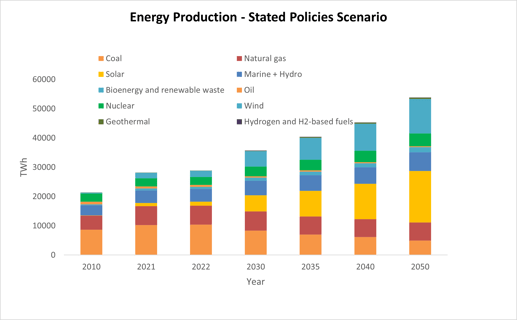

By analyzing the "Stated Policies Scenario" from the World Energy Outlook 2023, Wind and Solar energy are expected to grow the most by 2050. Nuclear energy is also expected to grow, but at a slower rate, with an overall share decrease to 8%, as shown in the graphs above. On the "Y" axis you can see TWh (Tera-Watts-hour), a unit to express energy.
All good for now, right? But what is nuclear energy? Well, that's how I would explain it to again my young sister:
Basically, any form of energy (used for electricity production), boils down to make a turbine spin (besides solar energy) and the spinning of the turbine generates electricity.
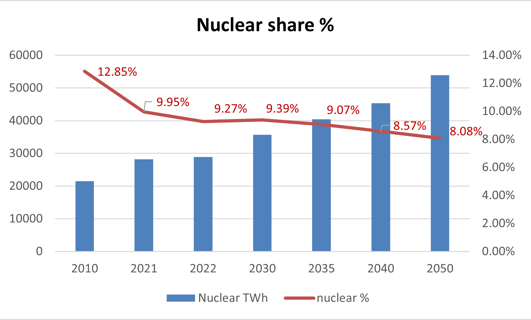

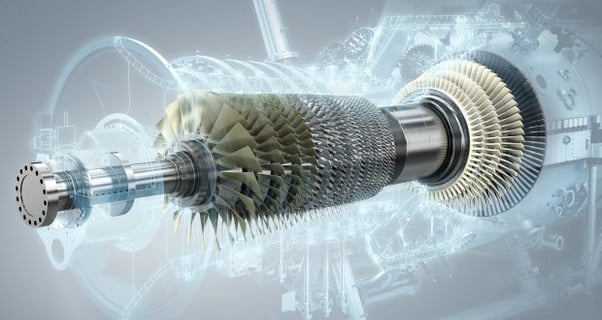

Siemens turbine design
We need something to make this fancy turbine spin so that the rotating energy can transform into electricity. In the case of windmills, that's wind, in the case of Hydroelectric plants, that's water from rivers or dams, in the case of most of the others, it's high-pressure steam.
In order to have high-pressure steam, you need heat, a lot of heat. How do we heat so much steam to generate enough electricity? That's where the creativity arrives! Thermoelectric plants heat water to become high-pressure steam, by burning natural gas or coal, geothermal plants use the natural heat of the Earth, and nuclear plants by something much more complex, which is the fission of Uranium.
To simplify, uranium is a special material, that if bombed by neutrons (if you have chemical doubts, I recommend reading the post How batteries work: basics for everyone) its atom splits in half. By splitting in half, a lot of energy (heat) is released, together with other 3 neutrons. Those 3 neutrons, will hit other uranium atoms, which will split again. This is called fission reaction and it's a chain reaction that generates tons of heat.
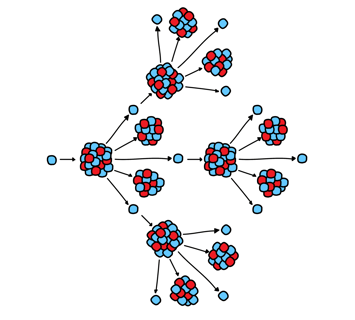

In the representation above you can see the fission chain reaction. A neutron (blue particle) hits the uranium atom, splitting it.
What is uranium though? Uranium is a very heavy metal with special properties used to generate energy. The largest producer of uranium on Earth is (by far) Kazakistan, but most of the natural reserves of uranium lay in Australia.
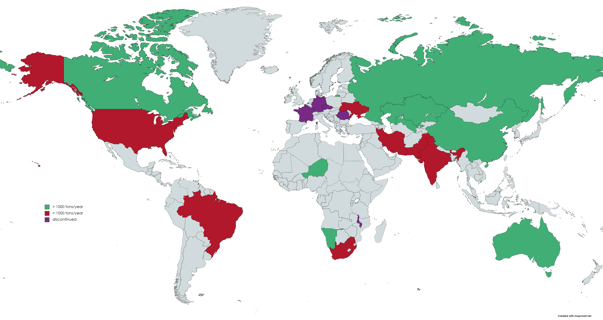

Uranium producers in the world by quantity (green>red, purple discontinued)
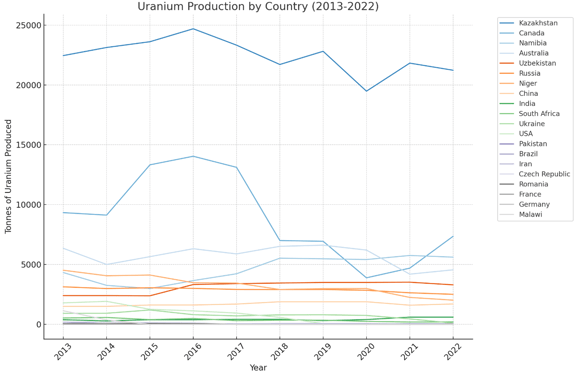

Uranium production 2013-2022

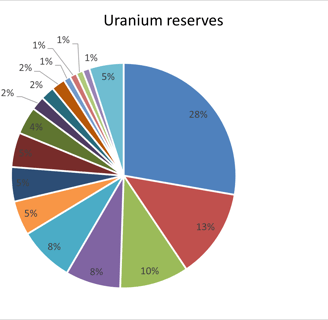
Uranium reserves
Hopefully, this bunch of graphs helped you more than being confusing.
Uranium is extracted from the soil and then processed to be used as fuel. The process is more or less as follows:
A yellowish rock, containing uranium is extracted, milled (crushed), and cleaned. At this point, we have an intermediate product called yellowcake.
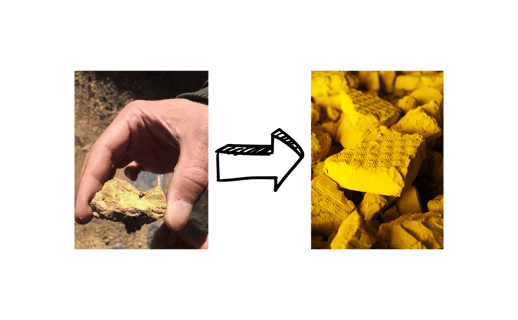

This yellowcake has a high amount of uranium, but mostly the wrong one. By "wrong" means, there are 2 kinds of uranium, Uranium 238 and Uranium 235. Uranium 238 has 3 neutrons more than Uranium 235. If you shoot Uranium 235 with a neutron, it will split (fission reaction), if you shoot Uranium 238 with a neutron, it will become Uranium 239 (absorbs the neutron). SO, the "right" uranium, the one we need, is Uranium 235, which is only 0.7% of the yellowcake.
Fear not! There's a way to increase the amount of Uranium 235 from the yellowcake, with a process called enrichment.
Yellowcake is enriched with uranium hexafluoride gas, centrifugated and compacted in pellets, cylinders of 1.2mm diameter and 2.0mm tall
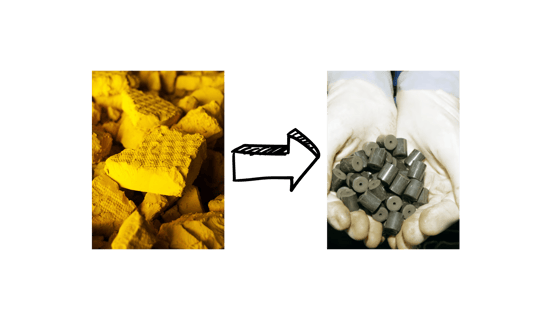

Those little cylinders are the fuel. If we align these cylinders one next to the other in a stainless steel case, we make a rod. If we assemble many rods we make an assembly and many assembly make a nuclear reactor.


In the image on the top right, you can see what a nuclear reactor looks like. Way far from the "Simpsons-like" green scary reactor, right?
Based on what kind of reactor we have, to control and slow down the fission reaction in case of overheating (and avoid incidents like Chernobyl and Fukushima), you take some of the rods out (less uranium in the reactor, means less material will be hit by neutrons) or you add some material that absorbs neutrons, like water or Cadmium rods (less neutron around, less Uranium will be hit).
As simple as that. The more uranium 235 in the rods is consumed in the fission reaction, the less efficient it becomes. When the process is considered inefficient (when around 90% of U-235 is left), they substitute those rods with the new ones.
Waste
Let's start with some fun comparisons:
1 gram of uranium contains the same energy contained in 3.75 tons of coal and 14,360 barrels of oil
Nuclear energy virtually does not produce any CO2 as waste material
Considering the same amount of land, a nuclear plant produces 500 times what a wind farm produces, and 100 times what a solar farm produces
The greatest incident in nuclear production was the Chernobyl disaster in 1986, where 30 people died immediately and 60 in the decades since due to radiation. Fukushima had 0 victims. Every year thousands of people die to extract coal.
Let's say that a power plant that doesn't emit CO2, is relatively safe, and can produce so much power for a unit of land, is worth considering.
Part of the waste, though, is the so-called "slag". When we talk about "slag" we suddenly imagine the fluorescent green corrosive substance in the Simpsons. Actually, it's the same uranium pellets you saw before, stored in casks as in the picture below. Truth is, this "spent" uranium is radioactive, but once stored in dry casks, you can stand next to it with no protection and no harm, as in the picture below.
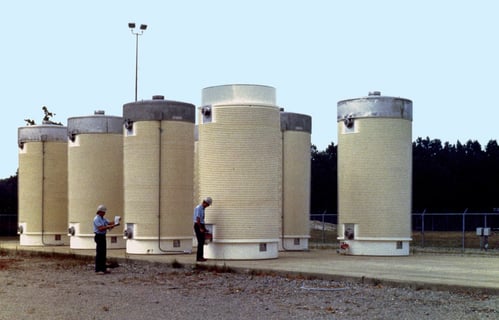

In some reactors, as aforementioned, the use of water is needed to slow down neutrons in the reactor. Water can also be used to cool down the reactor as a safety measure.
That water will likely contain tritium, which is just hydrogen with 2 neutrons in the nucleus. Tritium is radioactive and tritiated water must be handled with care, although the radiations emitted are beta-radiation, which can't penetrate our skin. The risk stands if we ingest or inhale a high concentration of tritiated water.
Here comes Fukushima. The Fukushima incident was caused by a big earthquake, which led to a tsunami, which led to the flooding of the nuclear plant. The flood caused 3 out of 5 reactors to melt down and the need to cool it down with a large amount of water (the equivalent of 5 Olympic swimming pools).
That water has been then filtered and cleaned. Tritium can't be filtered as hydrogen is too small to be caught by filters. So what did they do? They further diluted it.
If tritium is highly diluted, it's harmless. Fukushima water has been tested by IAEA (International Atomic Energy Agency) and has been considered safe. The radiation emitted by it is less than in drinking water and way less than in oceanic water.
Dilution and dispersion of highly diluted tritiated water is a common practice worldwide to eliminate tritiated water. It's completely safe and proven.
Reading scientific papers about nuclear plants around the world, the discharge of radionuclide-containing waste into the environment is highly controlled and safe.
I read a study, for example, about South Korean nuclear power plant waste dispersed in the environment. It measured the impact of radiation on the single individual with the highest exposure, called "MEI", which stands for "max exposed individual". In South Korea, there are 24 nuclear plants now active. The results show that the "MEI", is exposed to a range between 0.31% to 3.55% of the maximum recommended radiation exposure, in one year. It is literally a fraction. And the maximum recommended radiation exposure is less than half of the natural background radiation. Natural background radiation is the normal radiation emitted by our natural environment (radiation from soil, plants, rocks, etc.).
But it's not over, the highest radiations of these emissions released in the environment, are from a radioactive gas, made of an isotope of carbon (carbon-14). The tritiated water is not even the most radioactive component of waste discharged.
In conclusion, not only does everything around us emit natural radiation continuously and the recommended radiation exposure (on top of the natural radiation) is less than half of the natural radiation, but IF we live next to a nuclear plant that purposely releases radioactive waste in the environment, the exposure is still A FRACTION of the recommended maximum exposure.
So, as you can see, there is no scientific basis for being worried about Fukushima water discharge in the ocean, because it is already widely done safely by all of the other nuclear plants. Public condemnation from many countries, against the Japanese government's choice to release this water into the ocean, is clearly driven by something non-scientific.
As always, I will keep repeating my mantra in each of my posts. Try to understand how things work, before taking an alarmed and strong position on something. It's for our own sake and mental health. Let's make mass manipulation a bit harder by being more inquisitive.
Energy production by source in TWh - Stated Policies Scenario
Nuclear energy production and share % - Stated Policies Scenario
